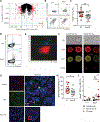Recurrent group A Streptococcus tonsillitis is an immunosusceptibility disease involving antibody deficiency and aberrant TFH cells
- PMID: 30728285
- PMCID: PMC6561727
- DOI: 10.1126/scitranslmed.aau3776
Recurrent group A Streptococcus tonsillitis is an immunosusceptibility disease involving antibody deficiency and aberrant TFH cells
Abstract
"Strep throat" is highly prevalent among children, yet it is unknown why only some children develop recurrent tonsillitis (RT), a common indication for tonsillectomy. To gain insights into this classic childhood disease, we performed phenotypic, genotypic, and functional studies on pediatric group A Streptococcus (GAS) RT and non-RT tonsils from two independent cohorts. GAS RT tonsils had smaller germinal centers, with an underrepresentation of GAS-specific CD4+ germinal center T follicular helper (GC-TFH) cells. RT children exhibited reduced antibody responses to an important GAS virulence factor, streptococcal pyrogenic exotoxin A (SpeA). Risk and protective human leukocyte antigen (HLA) class II alleles for RT were identified. Lastly, SpeA induced granzyme B production in GC-TFH cells from RT tonsils with the capacity to kill B cells and the potential to hobble the germinal center response. These observations suggest that RT is a multifactorial disease and that contributors to RT susceptibility include HLA class II differences, aberrant SpeA-activated GC-TFH cells, and lower SpeA antibody titers.
Copyright © 2019 The Authors, some rights reserved; exclusive licensee American Association for the Advancement of Science. No claim to original U.S. Government Works.
Conflict of interest statement
Figures






Comment in
-
Recurrent Tonsillitis Tfh Cells Acquire a Killer Identity.Trends Immunol. 2019 May;40(5):377-379. doi: 10.1016/j.it.2019.03.007. Epub 2019 Apr 4. Trends Immunol. 2019. PMID: 30956068 Free PMC article.
References
-
- Carapetis JR, Steer AC, Mulholland EK, Weber M, The global burden of group A streptococcal diseases. Lancet Infect. Dis 5, 685–694 (2005). - PubMed
-
- Shulman ST, Bisno AL, Clegg HW, Gerber MA, Kaplan EL, Lee G, Martin JM, Van Beneden C, Clinical practice guideline for the diagnosis and management of group A streptococcal pharyngitis: 2012 update by the Infectious Diseases Society of America. Clin. Infect. Dis 55, 1279–1282 (2012). - PubMed
-
- Ebell MH, Smith MA, Barry HC, Ives K, Carey M, The rational clinical examination. Does this patient have strep throat? JAMA 284, 2912–2918 (2000). - PubMed
-
- Schwartz RH, Kim D, Martin M, Pichichero ME, A reappraisal of the minimum duration of antibiotic treatment before approval of return to school for children with streptococcal pharyngitis. Pediatr. Infect. Dis. J 34, 1302–1304 (2015). - PubMed
-
- Van Brusselen D, Vlieghe E, Schelstraete P, De Meulder F, Vandeputte C, Garmyn K, Laffut W, Van de Voorde P, Streptococcal pharyngitis in children: To treat or not to treat? Eur. J. Pediatr 173, 1275–1283 (2014). - PubMed
Publication types
MeSH terms
Substances
Grants and funding
LinkOut - more resources
Full Text Sources
Medical
Molecular Biology Databases
Research Materials
Miscellaneous

